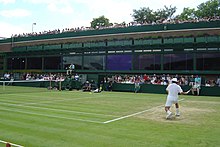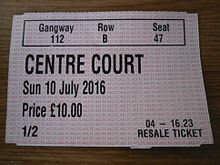Wimbledon Championships
The Club tested the new roof at an event called A Centre Court Celebration on Sunday, 17 May 2009, which featured exhibition matches involving Andre Agassi, Steffi Graf, Kim Clijsters, and Tim Henman.Murray was also involved in the match completed latest in the day at Wimbledon, which ended at 11:02 pm in a victory over Marcos Baghdatis at Centre Court in the third round of the 2012 Championships.[26] Part of the plan also includes acquiring the land of the adjacent Wimbledon Park Golf club for £65 million, so that the tournament qualifying matches can be played on site.[30] As a result of the COVID-19 global pandemic, the All England Club announced on 1 April 2020 that the entire grass-court season was to be cancelled as a public safety precaution until June 2021, marking the first time a Wimbledon tournament would not be played since World War II.[34] On 20 May 2022, the ATP, ITF, and WTA announced that they will not award ranking points for the tournament, as they considered the prohibition unilateral, and constituted discrimination against players based on nationality.On the first of these four occasions, Wimbledon staged a "People's Sunday", with unreserved seating and readily available, inexpensive tickets, allowing those with more limited means to sit on the show courts.[49] A statement from Wimbledon in 2018 read: “The 11pm curfew is a Planning Condition applied to balance the consideration of the local residents with the scale of an international tennis event that takes place in a residential area.Players and pairs who neither have high enough rankings nor receive wild cards may participate in a qualifying tournament held one week before Wimbledon at the Bank of England Sports Ground in Roehampton.As the attendance at the Championships grew, it became obvious before the First World War that the 8,000 ground capacity at Worple Road was inadequate, and so the Club started looking for a new site.Centre Court usually hosts the finals and semifinals of the main events, as well as many matches in the earlier rounds involving top-seeded players or local favourites.The suffragettes, as part of their campaign for women's votes before the First World War, had begun carrying out politically motivated arson and bombings across the country.[65] Social commentator Ellis Cashmore describes Wimbledon as having "a David Niven-ish propriety", in trying to conform to the standards of behaviour regarded as common in the 1950s.Writer Peter York sees the event as representing a particular white, upper middle class, affluent type of Britishness, describing the area of Wimbledon as "a southern, well off, late-Victorian suburb with a particular social character".Cashmore has criticised the event for being "remote and insulated" from the changing multicultural character of modern Britain, describing it as "nobody's idea of all-things-British".[66][importance?]The training includes weekly sessions of physical, procedural and theoretical instruction, to ensure that the BBGs are fast, alert, self-confident and adaptable to situations.[81] As of the 2022 edition of the tournament, the use of Mr, Miss and Mrs was eliminated: players are now referred to by their names, as written on the scoreboard by the umpire at all points in a match.Now, players are required to bow or curtsy only if the Prince of Wales or the King is present,[82] as was in practice during the 2010 Championships when Elizabeth II was in attendance at Wimbledon on 24 June.[83] On 27 June 2012, Roger Federer said in his post-match interview that he and his opponent had been asked to bow towards the Royal Box as Prince Charles and his wife were present, saying that it was not a problem for him.[citation needed] Wimbledon and the French Open are the only Grand Slam tournaments where fans without tickets for play can queue up and still get seats on the three show courts on the day of the match.At 2.40pm on Day Seven (Monday 28 June) of the 2010 Championships, the one-millionth numbered Wimbledon queue card was handed out to Rose Stanley from South Africa.[97][98] Wimbledon is notable for the longest running sponsorship in sports history due to its association with Slazenger who have supplied all tennis balls for the tournament since 1902.Reporters and commentators included Gigi Salmon, Nick Lestor, Rupert Bell, Nigel Bidmead, Guy Swindells, Lucie Ahl, Nadine Towell and Helen Whitaker.Current commentators working for the BBC at Wimbledon include British ex-players Andrew Castle, John Lloyd, Tim Henman, Greg Rusedski, Samantha Smith and Mark Petchey; tennis legends such as John McEnroe, Tracy Austin, Boris Becker and Lindsay Davenport; and general sports commentators including David Mercer, Barry Davies, Andrew Cotter and Nick Mullins.Highlights of the rest of the tournament must be provided by terrestrial stations; live coverage (excepting the finals) may be sought by satellite or cable TV.RTÉ made the decision in 1998 to discontinue broadcasting the tournament due to falling viewing figures and the large number of viewers watching on the BBC.In the United States, ABC began showing taped highlights of the Wimbledon Gentlemen's Singles Final in the 1960s on its Wide World of Sports series.[115] Live coverage started early in the morning (the US being a minimum of 5 hours behind the UK) and continued well into the afternoon, interspersed with commentary and interviews from Bud Collins.[117] The AELTC grew frustrated with NBC's policy of waiting to begin its quarterfinal and semifinal coverage until after the conclusion of Today at 10 a.m. local, as well as broadcasting live only to the Eastern Time Zone and using tape-delay in all others.[122] In Australia, the free-to-air Nine Network covered Wimbledon for almost 40 years but decided to drop their broadcast following the 2010 tournament, citing declining ratings and desire to use money saved to bid on other sports coverage.Most matches are also available for viewing through internet betting websites and other live streaming services, as television cameras are set up to provide continuous coverage on nearly all the courts.


















2024 Wimbledon ChampionshipsAll England Lawn Tennis and Croquet ClubCarlos AlcarazHarri HeliövaaraHenry PattenRoger FedererTodd WoodbridgeBarbora KrejčíkováKateřina SiniakováTaylor TownsendMartina NavratilovaElizabeth RyanJan ZielińskiHsieh Su-weiLeander PaesVic SeixasOwen DavidsonKen FletcherGrand SlamAustralian OpenFrench OpenUS Open2024 WimbledontennisLawn Tennis AssociationWimbledon, Londongrass courtsCentre Courtretractable roofNo. 1 CourtChampagneSlazengerCOVID-19 pandemicWimbledon 2020excluding players representing Russia and BelarusSpencer Goreinaugural Wimbledon Championshiplawn tennisWalter Clopton Wingfieldreal tennisMarylebone Cricket Club1877 Wimbledon ChampionshipguineaOld HarrovianracketsWilliam MarshallThe FieldshillingChampionship, 1884Maud WatsonguineasLadies' SinglesGentlemen's DoublesLadies' doublesmixed doublesBertrand Milbourne Clarkopen eraFred PerryAndy MurrayVirginia WadeAnnabel CroftLaura RobsonInternational Lawn Tennis FederationFrench ChampionshipsAndre AgassiSteffi GrafKim ClijstersTim HenmanDinara SafinaAmélie MauresmoStanislas WawrinkaMarcos Baghdatis2012 Gentlemen's SinglesNo. 2 CourtNo. 3 CourtSummer Olympic GamesWimbledon ParkCOVID-19 global pandemicbehind closed doorsTennis ChannelSARS outbreak2022 Russian invasion of Ukrainewould be prohibited from competingsingle-elimination tournamentsround-robin tournamentsQueen's Club ChampionshipsGerry Weber OpenHalle, GermanyEastbourneRosmalenBirminghamHall of Fame Tennis ChampionshipsNewport, Rhode IslandStuttgart Openwild cardseedings1924 Wimbledon Championships1927 Wimbledon ChampionshipsRené LacosteHelen WillsGoran IvaniševićBank of EnglandRoehamptonJohn McEnroeVladimir VoltchkovAlexandra StevensonInternational Tennis Federation2021 tournamentBoris BeckerRichard KrajicekMarketa VondrousovaVenus Williamsperennial ryegrassCreeping Red Fescue2012 Olympic GamesGreat Britain teamsDavis Cupgreen clayhard courts1908 Summer Olympic GamesWimbledon High SchoolStan Wawrinkaplanning permissionNo.3 CourtIlie NăstasePete Sampras